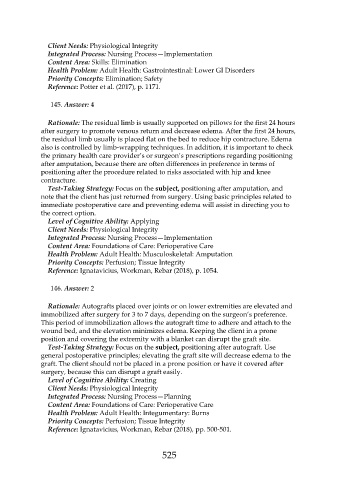Page 525 - Saunders Comprehensive Review For NCLEX-RN
P. 525
Client Needs: Physiological Integrity
Integrated Process: Nursing Process—Implementation
Content Area: Skills: Elimination
Health Problem: Adult Health: Gastrointestinal: Lower GI Disorders
Priority Concepts: Elimination; Safety
Reference: Potter et al. (2017), p. 1171.
145. Answer: 4
Rationale: The residual limb is usually supported on pillows for the first 24 hours
after surgery to promote venous return and decrease edema. After the first 24 hours,
the residual limb usually is placed flat on the bed to reduce hip contracture. Edema
also is controlled by limb-wrapping techniques. In addition, it is important to check
the primary health care provider’s or surgeon’s prescriptions regarding positioning
after amputation, because there are often differences in preference in terms of
positioning after the procedure related to risks associated with hip and knee
contracture.
Test-Taking Strategy: Focus on the subject, positioning after amputation, and
note that the client has just returned from surgery. Using basic principles related to
immediate postoperative care and preventing edema will assist in directing you to
the correct option.
Level of Cognitive Ability: Applying
Client Needs: Physiological Integrity
Integrated Process: Nursing Process—Implementation
Content Area: Foundations of Care: Perioperative Care
Health Problem: Adult Health: Musculoskeletal: Amputation
Priority Concepts: Perfusion; Tissue Integrity
Reference: Ignatavicius, Workman, Rebar (2018), p. 1054.
146. Answer: 2
Rationale: Autografts placed over joints or on lower extremities are elevated and
immobilized after surgery for 3 to 7 days, depending on the surgeon’s preference.
This period of immobilization allows the autograft time to adhere and attach to the
wound bed, and the elevation minimizes edema. Keeping the client in a prone
position and covering the extremity with a blanket can disrupt the graft site.
Test-Taking Strategy: Focus on the subject, positioning after autograft. Use
general postoperative principles; elevating the graft site will decrease edema to the
graft. The client should not be placed in a prone position or have it covered after
surgery, because this can disrupt a graft easily.
Level of Cognitive Ability: Creating
Client Needs: Physiological Integrity
Integrated Process: Nursing Process—Planning
Content Area: Foundations of Care: Perioperative Care
Health Problem: Adult Health: Integumentary: Burns
Priority Concepts: Perfusion; Tissue Integrity
Reference: Ignatavicius, Workman, Rebar (2018), pp. 500-501.
525

